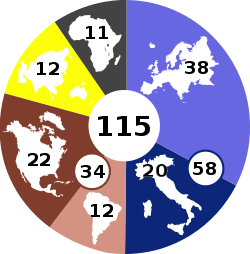2005 conclave
The 2005 conclave began on April 18, 2005 and ended the following day. Members of the College of Cardinals of the Catholic Church elected a successor to the late Pope John Paul II.
Cardinal Joseph Ratzinger, 78, since then known as Benedict XVI, was elected.
Composition
Voting
First day, Monday, April 18
The activities of the first day consisted of a morning Mass "for the Election of the Roman Pontiff" (Latin: Pro Eligendo Romano Pontífice) presided over by the dean of the College of Cardinals (then Cardinal Ratzinger) in St. Peter's Basilica, followed by the meeting of the cardinals in the Sistine Chapel of the Apostolic Palace of Vatican City in the afternoon for a round of voting.
The cardinals met first in the Hall of Blessings, at 4:00 pm Rome time, where there was a brief moment of prayer presided over by the dean. Then, they went in a procession, through the rooms of the Apostolic Palace, to the Sistine Chapel amid litany chants to the saints. After taking their places, the Veni Creator (Hymn to the Holy Spirit) was sung. The Dean of the College of Cardinals read the oath and then each cardinal elector affirmed the oath by placing his hand on the New Testament. Cardinal Ratzinger was the first to advance, followed by the vice-dean, Cardinal Angelo Sodano, and the rest of the cardinals. It was the first time that the eyes of the world could see this part of the ceremony.
Only Cardinals Baum and Ratzinger had previously participated in a conclave (those of 1978). Two cardinals were distinguished by their clothing; Cardinal Ignacio Moisés I Daoud of the Syrian Catholic Church and Cardinal Lubomyr Hussar of the Ukrainian Greek Catholic Church.
Later, Archbishop Piero Marini, Master of Pontifical Liturgical Celebrations, uttered the words "extra omnes" (everyone out), indicating that those who did not participate in the conclave should leave the premises. The choir members, security guards, ceremonialists, press, and other personnel then left the chapel and the doors of the Sistine Chapel closed, signaling that the cardinals began the conclave.
Black smoke (fumata negra) was observed on the ceiling of the Sistine Chapel around 8:00 p.m. local time, indicating that the first vote was over. carried out without the election of a new Pope.
Second day, Tuesday April 19
At noon there was black smoke again, but at 16:50 (UTC) there was white smoke. A new pope has been elected on the fourth ballot. At 17:04 (UTC) the bells of San Pedro rang greeting and confirming the election.
Later, Cardinal Protodeacon Jorge Medina Estévez appeared to give a polyglot greeting from the central balcony of the Basilica of Saint Peter and said the following words:
"Annuntio vobis Gaudium Magnum: Habemus Papam. Emminentissimum ac reverendissimum dominum, dominum Iosephum, Sanctae Romanae Ecclessiae Cardinalem Ratzinger; qui sibi nomen imposuit Benedicti XVI".
From that moment on, Joseph Ratzinger, who took the name Benedict XVI, was the one who succeeded John Paul II at the head of the Catholic Church, until his resignation, announced by himself on February 11, 2013 and effective on February 28. February, at 8:00 p.m. in Rome.
Summary table of participants
Statistics of the cardinal electors of the conclave according to their geographical origin. | |
| Elections | 117 total |
|---|---|
| Ausente | 2 (Jaime Sin, Adolfo Antonio Suárez Rivera) |
| Present | 115 |
| Africa | 11 |
| Asia and the Middle East | 11 |
| Europe | 58 |
| Oceania | 2 |
| America | 35 |
| PAPA FALLECTED | John Paul II (Karol Wojtyła) |
| NEW PAPA | Benedict XVI (Joseph Ratzinger) |
